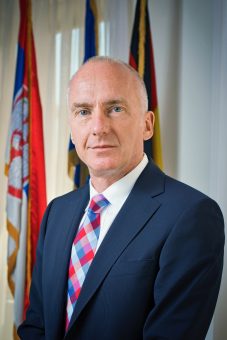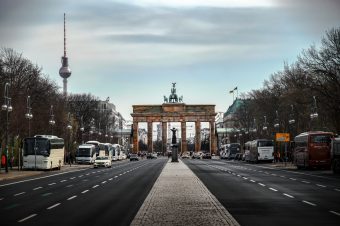
The term evolution, referring to a gradual and continuous social development, is often used as a total opposite to the term revolution, which brings sudden and dramatic shifts of the existing system. However, their meanings could be united in the energy transition – a process of phasing out dirty energy in favour of the clean alternatives to which the sky is the limit – or, to be precise, the Sun is the limit. We had an opportunity to talk to the ambassador of Germany to Serbia Thomas Schieb on how the energy is unfolding on German soil.
EP: March of 2019 was significant for the Energiewende. For the first time in history, Germany generated 54.5 per cent of electricity from renewables. How did your country get to this important milestone and what sources are contributing the most to its cleaner energy mix? What is the plan of Germany for renewables in the forthcoming years?
Thomas Schieb: Germany’s electricity supply is becoming “greener” every year. The share of renewables in has steadily grown over the last few years – from about 6% in 2000 to around 40% in 2018. By 2030, 65% of electricity consumed in Germany is to derive from renewables. Wind and solar energy remain the most important forms of renewables in Germany while biomass and hydropower also constitute valuable building blocks in the energy system.
The Renewable Energy Sources Act (EEG) has laid the foundations for the German “Energiewende” and was initially adopted in 2000 introducing feed-in tariffs (FIT) for electricity generated from sun, wind, water or biomass for 20 years. The costs of this were passed on to the electricity consumers via the “EEG surcharge”. The funding from the EEG surcharge transformed renewable energy from a niche product into an essential energy source in the power mix. Advances in technology have since significantly cut the costs of generating electricity from renewable sources. However, the rapid expansion of renewables also caused the EEG surcharge to rise considerably until 2014.
The Government reformed the EEG in 2014 and in 2016 to specify a gradual transition from FITs to an auction system.
As Germany is phasing out nuclear power by 2022 and coal-fired power by 2038, the use of renewable energy sources will be expanded. Currently, the main challenge lies in the expansion and modernization of the power grid. An additional 5,800 km of high voltage transmission lines are required to transport power from abundant renewable sources in Northern Germany to the industrial centres in Western and Southern Germany. The German Federal Government has therefore made the German grid expansion a key priority.

EP: What regulations and political actions are implemented in Germany to encourage citizens to invest in solar panels on their roofs and energy efficiency in their houses?
Thomas Schieb: In 2016, Germany adopted the National Action Plan on Energy Efficiency (NAPE) to reduce primary energy consumption by 20 per cent by 2020 compared with 2008, and by 50 per cent by 2050. NAPE defines three central aims: Firstly, to provide information and advice on energy efficiency to citizens, companies and municipalities. Secondly, to promote investments in energy efficiency in innovative ways. NAPE includes increased funding, e.g. for KfW Germany’s “CO2 Building Modernisation Programme” (for energy-efficient construction and retrofitting) or for various funding programmes for energy efficiency in companies. Thirdly, to introduce mandatory energy audits for large companies as well as new energy standards for new appliances and buildings.
EP: How will the miners and the workforce that is trained to work in the fossil fuels sector be transitioned to low carbon future when it comes to positioning them on the job market?
Thomas Schieb: In May 2019 the Government announced the allocation of up to EUR 40 billion by 2038 for the structural transition of Germany’s coal-mining areas, which will include incentives for industries, investments in infrastructure as well as the establishment of new public research and administration institutions. Through a special program, a total of EUR 240 million have been allocated for immediate and short-term support to the regions. These measures will create future-oriented and well-paid jobs in the affected areas.
EP: In a policy reversal following Japan’s Fukushima Daiichi nuclear disaster, it was decided that Germany’s 17 nuclear power stations will be shut down by 2022. How far have you gone with their closing?
Thomas Schieb: After the shut-down of two nuclear power plants in 2015 and 2017, seven nuclear power plants are currently in operation. Of these, one will be shut down in 2019, three more in 2021 and 2022 each.

EP: What were Germany’s greenhouse gas emissions, the share of renewable energy and energy efficiency targets under Europe 2020 and will all of them be achieved successfully?
Thomas Schieb: In 2018, Germany emitted 866 million tons of CO2 equivalents (4.5% less than in 2017 and more than 30.5% less than 1990).
The share of renewable energy in the production of electricity was about 40%. In the entire energy mix, the share was about 17%.
When it comes to energy efficiency, Germany has reduced the consumption of primary energy by 10% compared to 2008.
While we are confident that the 2020 goals for the share of renewable energy will be reached, it is unlikely that despite all progress our national 2020 targets for the reduction of GHG emissions and energy efficiency can be achieved.
Interview by: Jelena Kozbasic
Read the whole interview in the new issue of the Energy portal Magazine on CLIMATE CHANGE, september-november 2019.



